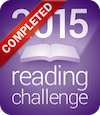 I’m going to go ahead and write my reading review before the new year this time, because I don’t have the slightest intention of finishing another book before 2016 rolls around. Aren’t you so happy? It’s like an early Christmas present, only it’s an early New Year’s present! That no one actually wants!
I’m going to go ahead and write my reading review before the new year this time, because I don’t have the slightest intention of finishing another book before 2016 rolls around. Aren’t you so happy? It’s like an early Christmas present, only it’s an early New Year’s present! That no one actually wants!
By way of shortcut, if you want a straightforward list of books read this year, you can get that here for another couple of weeks, and then here afterward. Or you can check my Goodreads 2015 reckoning if you’d prefer.
Every year I go through and make lists and graphs to analyze my reading, to absolutely no purpose because it’s not as if I ever make adjustments or anything. I read what I like when I like to read it and do my best to feel no shame when that ends up being a long string of vampire-infested romance novels. (Although, I’d argue strenuously that this year’s quasi-embarrassing series, The Black Dagger Brotherhood, might be more accurately described as romance-infested vampire novels.) Then I take those lists and graphs and turn them into a blog post that I’m sure pretty much no one actually enjoys except myself — and they are a highlight of my New Year every time. 🙂
If you’re the rare individual who actually does find this interesting, you can find my previous years-in-books here: 2014, 2013, 2012,2011, and 2010.
I track my books on Goodreads and do their annual reading challenge, in which you just set a goal and try to read that many books. This wasn’t a particularly great year for my reading, and I honestly wouldn’t have met my goal if I hadn’t included a handful of picture books that I read with Henry or on my own in December. This has been a really full-speed-ahead year at work, plus I’ve spent the majority of the year in varying degrees of “pregnant with a two-year-old,” so my stats are down. But since I just do it for the fun of it anyway, I’m not concerned.
This year I set a goal of 75 books and ended up reading 81. That isn’t as great as last year’s even 100, but it isn’t the worst of the past six years I’ve been tracking.

That comes out to about 25,000 pages this year.
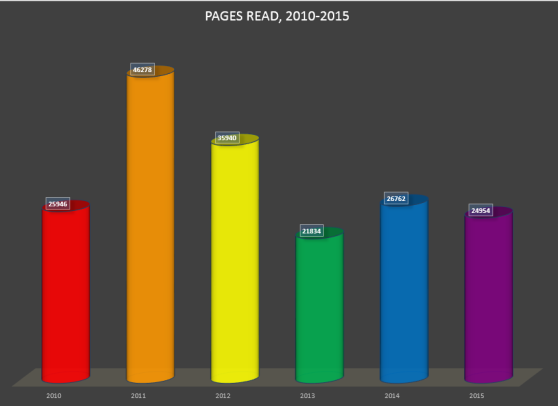
As a teacher, I definitely have “seasons” for reading. I obviously get a lot more read in the summer than in the school year, usually with a spike in December/January due to Christmas break and the really long dark evenings here. I like to track month-to-month reading, again just for the heck of it.
Here’s this year in books, monthly:

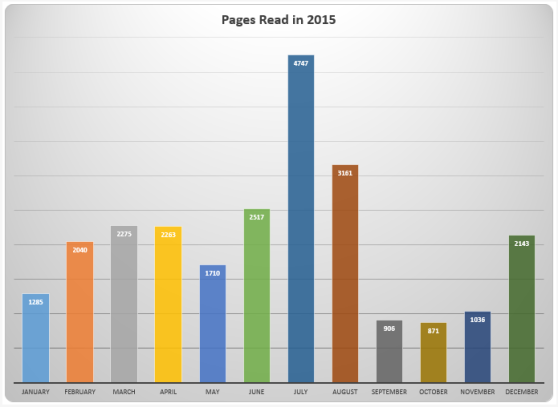
That’s a nice bump in books in December, but not so much pages — lots of picture books. 🙂 As anticipated, my real peak reading took place in July.
And of course, because there’s no such thing as too many graphs, I compared monthly reading for the past six years:


These are kind of interesting to me (although getting harder to read each year — may no longer be a usable format) because I can see not only how each year stacks up to the next, but whether I have a consistent trend in terms of when I’m doing my reading. Why was the late winter of 2011 such a humdinger? What was the difference between the late fall of 2011 vs. 2013? Intriguing.
As previously noted, this year I devoted a lot of pages to J. R. Ward’s Black Dagger Brotherhood series, which is an interesting beast. I absolutely despise the titles and covers of these books, to the point where I have on many instances refused to read them in public and do my best to hide my updates on them from my Facebook and Goodreads feed. Why, you might ask? Well, let me allow some pictures to speak for themselves.
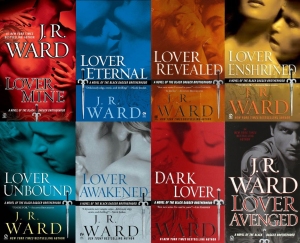
At a glance, it’s pretty obvious what these books are about, right? Lover this, lover that, shirtless people necking. What are you reading, Mrs. Baker? Scandalous!
In fact, although there are some pretty detailed steamy scenes in each of these, they really aren’t romance novels at all. They’re urban fantasy action/adventure stories about a group of vampiric soldiers who fight a (somewhat vaguely-explained) ongoing war against bad guy slayers while also battling various psychological or physiological battles in their personal lives. Lots of fight scenes, suspenseful storylines, intrigue, etc.. And in fairness, in each book, one of the vampires falls in love and is saved (literally and/or figuratively) by the object of his affection… so I guess that’s what makes them romance novels, in a blood-drenched Byronic sort of way. They’re fun, fast-paced, and don’t require a lot of emotional or mental investment, which is pretty perfect for me at this stage in my life. So yeah, romance-infested vampire novels, rather than vampire-infested romance novels.
But I mean… seriously. Were these titles and cover art decisions really necessary? Were they Ward’s idea or did she fall victim to a publisher who wanted to market these their way? The titles alone sometimes have only a tangential relationship to the plot — my “favorite” probably being Lover Avenged, in which vengeance played a really minor role in the big scheme of things. And the covers? Again — seriously? Of the sampling above, only Lover Avenged and perhaps Lover Mine (top left and bottom right corners) really reflect the characters within in any way; the others are all anonymous torsos airbrushed to emphasize the HOT SEXINESS of these books while I’m just sitting here, reading about vamp-warriors beating the crap out of bad guys and trying to hide the cover of my paperback. Stupid problems, I know.
I read a fairly unmemorable smattering of fantasy in an attempt to find another series that held my interest as effectively as the Dresden Files. The best of these was the Monster Hunter series by Larry Correia, an author I wrestled with because I find his Sad Puppy associations quite distasteful, but whose books are pure fun for someone who likes the sort of books I like. His Hard Magic series, which was the interesting blend of alt-history urban fantasy, was also a lot of fun. I also finished, with some sadness, Kim Harrison’s The Hollows series, which I enjoyed very much and will probably end up re-reading at some point.
I also read some rather good picture books, a couple of decent graphic novels, the slightly-disappointing next installment in Kiera Cass’s Selection series, the really-quite-good Seraphina, and the excellent-as-expected Lock In and The Human Division (AND I got to meet the author!) I also read a couple of good “serious” books, my favorite of which was All the Light We Cannot See by homeboy Anthony Doerr. Oh, and I read the first two volumes in the Game of Thrones series, which I enjoyed, but hadn’t been especially inspired to go on to the next book just yet.
My least favorite books of the year were Halfway to the Grave (just unremarkable), Go Set a Watchman (yep, should not have been published), As You Wish: Inconceivable Tales from the Making of the Princess Bride (which I really wanted to like but just found disappointing), The Unbearable Lightness of Dragons (ditto, but not surprised — I haven’t been able to enjoy these books since the focus shifted away from Aisling Grey), and Loki’s Wolves (for which I had high hopes, but turned out to be a weak Percy Jackson knockoff — and given my mediocre opinion of PJ, that’s saying something).
And my 2015 obscure recommendation for all y’all out there in DYHJ-land?
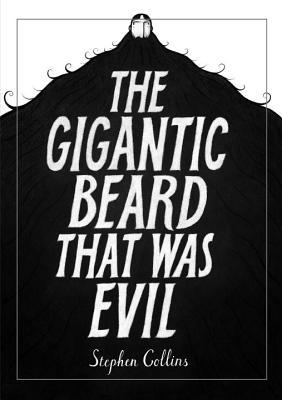
I really got a kick out of this graphic novel. It’s unlike anything I’d ever read before. Thought-provoking, aesthetically intriguing, and readable on multiple levels — like, I’ve had sixth graders check it out and find it fun and silly, and I’ve also imagined a unit where I use it with twelfth graders alongside 1984 to discuss dystopia/utopia, societal norms/taboos, and philosophy. It may be a little hard to get your hands on it, as it’s not the cheapest book ever, but it was published in October 2014 so you can still find it on Amazon and in your better libraries (like mine ;)).
Lest I forget, here’s my annual Pie Chart of Genre Happiness:

I categorize books into as many genres as seem appropriate — usually between 1-3 — and see how things break down. Every year, urban fantasy/paranormal romance makes up a good chunk of my reading; it’s just what I like to read for fun, especially in the dark winter months. Picture books honestly make up a bigger chunk than is represented, but I only count them once, and then only if they have something akin to a plot, were worth the trouble to log into Goodreads and mark them down, and if I remember to do it (or am coming up short on my yearly goal and need to bump up my stats). This year was shockingly bad for MG/YA books — I’ve had a hard time getting my mind to focus on “professional reading,” which this is for me, and there haven’t been as many new releases that commanded my attention. Will need to try harder next year. Somehow my label for general/realistic fiction lost its tail; it’s the sagey-green wedge between fantasy and graphic novel.
